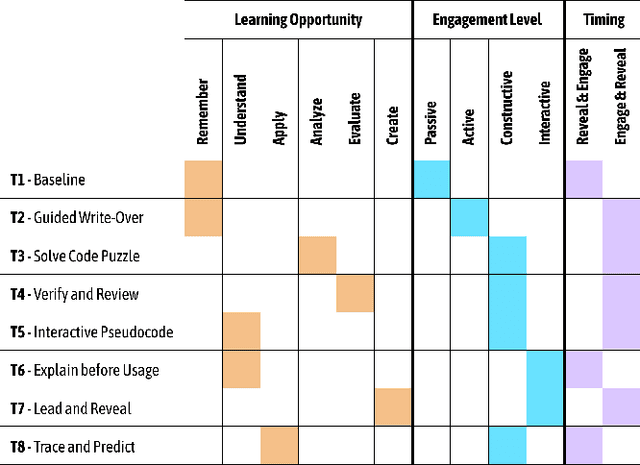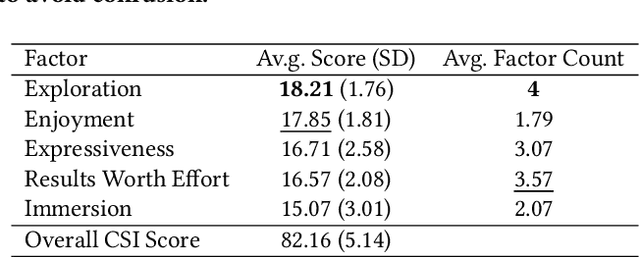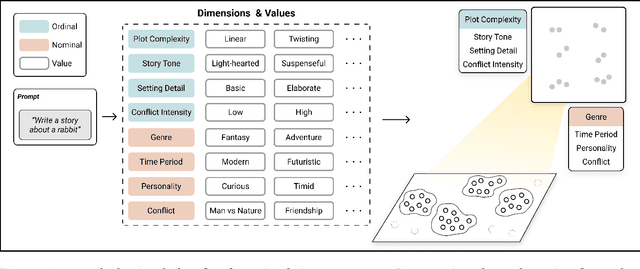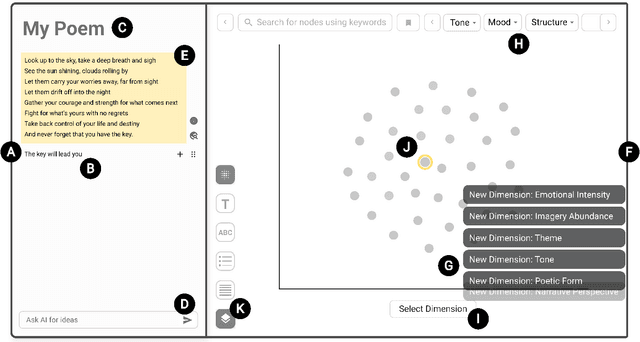Sangho Suh
Exploring the Design Space of Cognitive Engagement Techniques with AI-Generated Code for Enhanced Learning
Oct 11, 2024



Abstract:Novice programmers are increasingly relying on Large Language Models (LLMs) to generate code for learning programming concepts. However, this interaction can lead to superficial engagement, giving learners an illusion of learning and hindering skill development. To address this issue, we conducted a systematic design exploration to develop seven cognitive engagement techniques aimed at promoting deeper engagement with AI-generated code. In this paper, we describe our design process, the initial seven techniques and results from a between-subjects study (N=82). We then iteratively refined the top techniques and further evaluated them through a within-subjects study (N=42). We evaluate the friction each technique introduces, their effectiveness in helping learners apply concepts to isomorphic tasks without AI assistance, and their success in aligning learners' perceived and actual coding abilities. Ultimately, our results highlight the most effective technique: guiding learners through the step-by-step problem-solving process, where they engage in an interactive dialog with the AI, prompting what needs to be done at each stage before the corresponding code is revealed.
Structured Generation and Exploration of Design Space with Large Language Models for Human-AI Co-Creation
Oct 23, 2023



Abstract:Thanks to their generative capabilities, large language models (LLMs) have become an invaluable tool for creative processes. These models have the capacity to produce hundreds and thousands of visual and textual outputs, offering abundant inspiration for creative endeavors. But are we harnessing their full potential? We argue that current interaction paradigms fall short, guiding users towards rapid convergence on a limited set of ideas, rather than empowering them to explore the vast latent design space in generative models. To address this limitation, we propose a framework that facilitates the structured generation of design space in which users can seamlessly explore, evaluate, and synthesize a multitude of responses. We demonstrate the feasibility and usefulness of this framework through the design and development of an interactive system, Luminate, and a user study with 8 professional writers. Our work advances how we interact with LLMs for creative tasks, introducing a way to harness the creative potential of LLMs.
Sensecape: Enabling Multilevel Exploration and Sensemaking with Large Language Models
May 19, 2023



Abstract:People are increasingly turning to large language models (LLMs) for complex information tasks like academic research or planning a move to another city. However, while they often require working in a nonlinear manner - e.g., to arrange information spatially to organize and make sense of it, current interfaces for interacting with LLMs are generally linear to support conversational interaction. To address this limitation and explore how we can support LLM-powered exploration and sensemaking, we developed Sensecape, an interactive system designed to support complex information tasks with an LLM by enabling users to (1) manage the complexity of information through multilevel abstraction and (2) seamlessly switch between foraging and sensemaking. Our within-subject user study reveals that Sensecape empowers users to explore more topics and structure their knowledge hierarchically. We contribute implications for LLM-based workflows and interfaces for information tasks.
 Add to Chrome
Add to Chrome Add to Firefox
Add to Firefox Add to Edge
Add to Edge